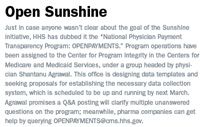Full Disclosure for Pharma
Pharmaceutical Executive
There seems no end to demands for data on clinical research, conflicts of interest, company payments, and drug prices.
Although recent legislation and regulations have greatly expanded the range of information that pharmaceutical companies have to unveil to the public, there's an escalating demand for even more transparency. The new "Sunshine" law is just the tip of the iceberg, requiring drug and medical device companies to report virtually every penny they transfer to physicians and teaching hospitals, whether for conducting research, consulting, or providing free lunches. The theory is that disclosure of financial relationships between manufacturers and prescribers will shed light on medical treatment decisions—particularly for new, more costly medicines versus older, cheaper treatments.

Jill Wechsler
The Sunshine Act, in part, expands a well-established FDA rule requiring sponsors to include information on payments to clinical investigators in market applications for new drugs and medical products. That policy aims to uncover financial relationships that could shape how an investigator handles or assesses study results and avoid situations that could compromise the validity of clinical trial data or the safety of study participants. FDA recently published an update to that policy in response to complaints about lax oversight of the program, clarifying how to submit information on various financial arrangements.
Trial transparency
In addition to reporting payments to independent researchers, there's a broader clamor for transparency in clinical trial activities and study results. After years of reluctance, most pharma companies now post information on active clinical trials on the federal clinicaltrials.gov website. Such listings inform patients of opportunities to enroll in research, and also provide a baseline of clinical studies subject to fuller disclosure of trial result summaries after product approval.
Now regulators and health advocates seek to expand disclosure to include findings on all clinical trials, even those for drugs that fail to gain market approval. Leading medical journals are working with European Union officials to promote the AllTrials effort to register and disclose results from all clinical trials around the world. Trial summaries are not enough; safety advocates and industry critics seek disclosure of patient level data and case report forms so that they can verify the sponsor's research results and product claims. Disclosure advocates maintain that it's only fair to clinical trial participants to make available the results of their studies to illuminate further research, pointing out that scientists can learn much even from failed studies.
This call for greater data transparency reflects charges that sponsors have hidden important safety information from regulators and the public. Pharma companies counter that full disclosure can raise patient privacy issues and lead to misinterpretation of findings by non-experts. Abbott's pharma spin-off AbbVie has filed suit to prevent the European Medicines Agency from releasing patient-level clinical trial data, as has InterMune of California.
Yet, a number of pharma companies are adopting a full disclosure policy, some building on research disclosure requirements set in consent agreements negotiated with the Department of Justice and other federal and state enforcers. In February, GlaxoSmithKline announced it would release patient-level data as part of a new "openness" policy. In addition to posting notices on new trials and result summaries, the company will make available clinical study reports for all medicines—approved and discontinued—after results are published. Access to the data (which will be anonymized) will be limited to bona fide researchers and vetted by an independent expert panel.
Roche is taking a similar stance, partly in response to criticism over hiding clinical trial safety reports on its Tamiflu influenza treatment. Roche has formed an independent body to assess outside requests for patient data from trials supporting market applications and will make such information available after product approval in the United States and Europe.
Price transparency
An equally important goal of US transparency advocates is to reduce healthcare spending through competition generated by broader disclosure of prices for healthcare services and medical products. The new online "marketplaces" established by Obamacare for consumers to shop for health insurance will feature comparative information on plan premiums, co-pays, and benefits, along with drug formularies and pharmacy coverage policies, to help identify the best deal for an individual on coverage and costs. Plan sponsors will work to sort out the plethora of discounts and rebates that camouflage actual drug charges, particularly the higher co-pays and coinsurance rates on costly "specialty" drugs. Exorbitant prices for new treatments for cancer and other serious conditions are generating demand for information on how specialty pharmacies distribute and dispense these therapies and whether tiered formulary arrangements and pharmacy management systems limit appropriate access or prevent excessive outlays.

Open Sunshine
Disclosure of information on drug coverage and costs has gained support from a steady supply of reports on pharma pricing issues from federal investigators. One analysis issued in February by the HHS Inspector General found millions in overpayments for drugs covered by Medicare Part B under the current average sales prices reimbursement formula. Another study criticized inadequate conflict-of-interest assessment for members of Medicare drug plan formulary committees, a factor that supposedly could bias committee judgment in drug selection decisions. The Government Accountability Office recently investigated and called for changes in how Medicare pays for drugs used in dialysis treatment.
Consumer advocates and pharma critics maintain that full disclosure of drug prices will lead to much lower costs for patients. Pharma companies counter that such transparency will only boost prices overall, especially for those customers that currently enjoy favorable rebates and discounts. Industry's biggest fear is that some kind of national formulary will lead to reference pricing, higher rebates, and eventually drug price controls.
Social media exposure
Over the long run, though, much information on pharma research and prices will become public with the expansion of global search engines able to tap into millions of queries and postings on medical treatments and healthcare costs. A recent study by scientists at Microsoft Research, Stanford, and Columbia University, published in the Journal of the American Medical Informatics Association (March 6, 2013), found that Internet searches on drug use uncovered previously unrecognized adverse events. Here, queries from six million people in 2010 searching for information on antidepressant Paxil and cholesterol treatment Pravachol disclosed a greater incidence of high blood sugar in patients taking the two drugs.
It's not hard to imagine similar analyses of consumer searches for lower drug prices, product safety reports, and complaints about pharma marketing and advertising from health professionals and the public. The ultimate question is whether such disclosure enhances patient care—or adds to the complexities of innovative research.

Jill Wechsler is Pharm Exec's Washington correspondent. She can be reached at jwechsler@advanstar.com.

Pfizer, GSK Gain ACIP Recommendations for RSV and Meningococcal Vaccines
April 18th 2025The Centers for Disease Control and Prevention’s Advisory Committee on Immunization Practices voted to expand access to Pfizer’s respiratory syncytial virus vaccine Abrysvo for high-risk adults in their 50s and voted in favor of GSK’s meningococcal vaccine, Penmenvy, for streamlined adolescent protection.
Navigating Distrust: Pharma in the Age of Social Media
February 18th 2025Ian Baer, Founder and CEO of Sooth, discusses how the growing distrust in social media will impact industry marketing strategies and the relationships between pharmaceutical companies and the patients they aim to serve. He also explains dark social, how to combat misinformation, closing the trust gap, and more.